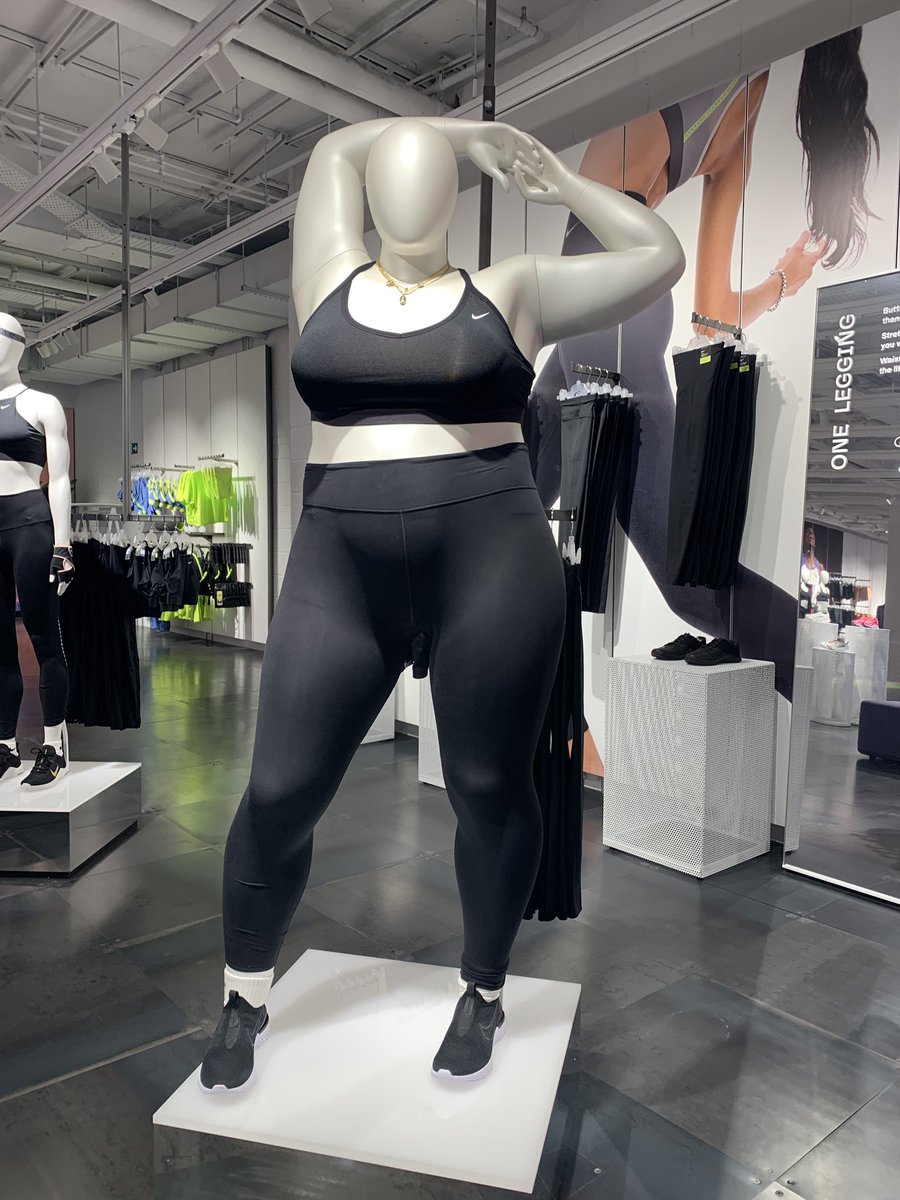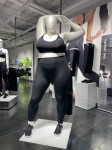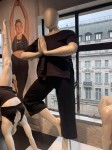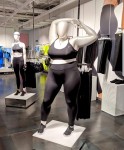
The average American woman currently wears between a size 16–18, yet a lot of designers continue to ignore this fact. There’s also the issue of how to display plus-size clothes in stores; the standard mannequin size is a two. Nike is the latest company to start using plus-size mannequins; as of Wednesday, they are now in its London flagship store:
Nike knows that most women aren’t a size 0 — and the company finally got the mannequins to prove it.
The activewear retailer unveiled a line-up of curvy mannequins at its new-and-improved London flagship store Wednesday as part of a special floor dedicated just to women.
NikeTown says its third level now features “a full range of athlete figures” with “multiple plus-sized and para-sport mannequins” for the first time in the store’s history.
Kaiser mentioned that Nike is probably doing this ahead of Wimbledon, which starts July 1st. The timing allows them to draw attention to and celebrate the diversity of athletes and Nike customers. People notes that Nordstrom did the same last month, and that Old Navy brought back plus sizes to stores last year, along with mannequins to display the clothing. Target and David’s Bridal have also brought plus-size mannequins into their stores. In the case of David’s Bridal, the article notes, “This plus-size mannequin was an attempt to keep up with real American women, not just models — and it worked. In 2012, the company was valued at $1 billion.”
As someone who spent most of the last year of graduate school sitting and writing a dissertation, and who continues to spend most of her day on the computer, working, I shop almost exclusively in the plus-size departments of most stores, which are often hit-or-miss. Some have almost no clothing. Some have clothing that I can’t quite believe got someone’s “OK” to manufacture. I was pleasantly surprised when I walked through Kohl’s the other day and realized that there were mannequins in the women’s section that were being used to properly, clearly display some of the clothes. Most of my exercise clothes are Champion, but I might check out what Nike is offering. I think it’s also neat that they are displaying para-sport mannequins, too, though I can’t seem to find any pictures of them.
Photos credit: Tanya Compas and Ashley Stokes via Twitter, tweets below.
Idk why but this @Nike mannequin makes me feel so empowered. pic.twitter.com/sWdkPEdfMN
— Ashley Stokes (@_AStokes_) June 6, 2019
Nike Town in Oxford Circus have opened up a new women’s space on the third floor and for the first time have plus sized mannequins modelling sportswear! pic.twitter.com/FOahIJNFu0
— Tanya Compas (@TanyaCompas) June 6, 2019














Didn’t the average size used to be a size 12? When did it change?
Sorry, do not know if links work, but the International Journal of Fashion Design, Technology and Education published a study in 2016, showing that the size 14 average was based on outdated information.
https://www.tandfonline.com/doi/abs/10.1080/17543266.2016.1214291?journalCode=tfdt20
When Americans really started stress-eating when their 401ks tanked.
In the Uk I the average size is or was a size 12 but a US size 0 is equivalent to a UK size 4 I think. When we read an article like this, it all becomes rather confusing but unless you’re a child or very petit person, you’re highly unlikely to be a US size 0 or a UK size 4.
Sizes have been changing constantly.
In the 1930s, a ladies size 14 was a 32 inch bust and 35 inch hip.
In 1967, Twiggy wore a size 8 (31-23-32). Today she’d wear a size 00.
In 1983, Joan Collins wore a size 8 (32-23-34). Today she’d wear a size 2.
In 1995, a size 8 was 35-27-35. Today it’s a size 6.
In 1973 I wore a size 6 (32-22-32). I continued to wear a size 6 for the next 40 years, even though I gained 30 pounds during that time period. The clothing got bigger but the size numbers got smaller. I now wear an 8 or a 10 but my measurements are 38-33-40.
This was interesting, thank you.
I don’t know how this size thing is decided – averages? Because I know I bring 3 sizes of the same pair of jeans and it can vary even with the same brand..
They should just go by measurements, like men’s.
I liked seeing this curvy mannequin! Larger people exercise and wear Nikes, and it’s great if these folks stop being invisible in marketing. Next maybe the company could lower the bustline an inch or 2 on a mannequin, to represent us older gals! 🙂
That top pic was taken at a very unfortunate angle. She appears to have a dangly piece at her crotch.
I had to look after reading your post,😅I think it’s the arm of a jacket hanging in the background!
ha! You are right. I scrolled back up to look.
I’m sorry if this is a stupid question, but how come men don’t have different-sized mannequins, too?
Because men still wear the same sized pants they wore in high school. They’re just slung really low because their beer bellies get in the way.
*cue faux concern from the peanut gallery about how this normalizing being “unhealthy” or some other nonsense from people who are completely unaffected by it followed by raging Internet arguments about the state of Western healthcare*
Veronica – you are correcT! I’ve already read comments that this glorifies being overweight and makes it ok -_-
People can be such a waste of space sometimes.
lmao @Veronica S. Yup.
Whether you like it or not, 30%+ of the population being overweight or obese is a huge public healthcare issue/crisis. Does that mean we should feel free to fat-shame individuals and criticise companies for catering to people of different sizes? Obviously not. Respect other people’s bodily integrity and all the usual boundaries. But the conversation about public health budgets and healthcare is legit.
It’s such a relief to see a more realistic representation of the human body! I’m considered relatively skinny, at a size 6–8, and even I have been feeling excluded by the fashion industry. I do feel angry, because even with a small bust, I’ve started needing to buy shirts in size L. Who are they making these shirts (in the regular Women’s department) for? It’s not this 34A, I’ll tell you that.
They’ve normalized extra-skinny sizes and make normal sized people feel like blimps. Most of us could use some more exercise (especially me), but we don’t need to be shamed for having average bodies.
Why does it have a penis sock???
They must’ve taken the term plus-sized and applied it to the clitoris. 😜
I understand one woman’s size 16 will look different on another woman because of different body types so designers like to use very small framed women with little curves to have more control over how the clothes hang but when it comes to actually selling clothes real women wear daily, not just the art you have on a runway that aren’t necessarily ‘user friendly’ it makes no sense to ignore plus size women. You are cutting your profits doing that
I’m still not sure describing plus-size as “curvy” is the way to go because there are women out there who are thinner/more fit with large busts or large butts, and there are women who are plus-size but are more straight up and down than hour glass.
I love this! Women come in all shapes and sizes.
this is a good start, but actually there should also be mannequins to cover the range of sizes in between too. If the purpose of the mannequin is to demonstrate what the clothes look like on people.
Sorry, I can see how being fat-shamed as an individual, in public, is nasty and wrong, and how not being able to find appealing clothing in your size is annoying. However, it’s a fact average weights have gone up for both men and women since 1960s. Obesity and overweight are associated with all the not-so-good stuff I won’t go into here. Businesses should cater to all sizes and we should encourage inclusion and respect of people’s bodies and the boundaries that discourage fat-shaming/body-shaming individuals, but at the same time, the conversation shouldn’t all be how this is great stuff for body image. When one is saying this is 100% good stuff, you should qualify it with the need to maybe review diets, junk food availability, lifestyle, etc. It’s a public health and healthcare budget issue whether you like it or not. In Japan the GPs happily fat-shame their patients if they pile on the pounds because they know it’s better for the patient’s health outcomes.
No one cares, Anon.